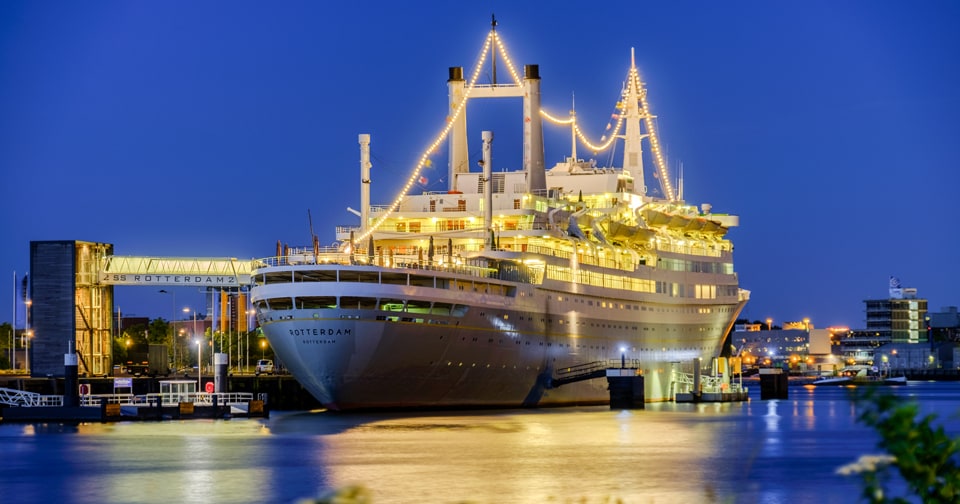
When we try to predict the future, it is helpful to understand the past. As the theme of this year’s FCSI EAME conference is The Future of Food and Hospitality, it is fitting that the venue is an object lesson in how history can be reinvented to combine the best of both tradition and innovation.
As attendees walk the decks and hallways of the SS Rotterdam, which lies at anchor in the heart of the city that gave the ship its name, near the old quarter of Katendrecht, many will be unaware of its rich history. The elegant and imposing steamship came into service in 1959 as the flagship of Holland America Line, and is the largest passenger liner ever built in the Netherlands. With interiors and furnishings designed by many of the country’s most notable architects and artists of the time, it was seen as a floating work of art. Now, after decades of carrying passengers to and from Manhattan, then many further voyages to the Bahamas, South Africa and other exotic destinations, she has become a world-class hotel on the water.
Since 2010, the ship has been open for tours, conferences and business functions, and has become well known for its hotel and dining facilities. While she has largely kept her original character, the refurbishment project was extensive and extremely challenging, as Gerben van der Molen FCSI, founder of hospitality and hotel design consultancy Stars Design explains.
“In the 1990s, the ship was about to be reused for parts and for steel, but many people said that the ship was too important to this country’s history to be broken up,” he says. “It was bought by a group of supporters who wanted to keep it in Rotterdam and make it a commercial venture rather than a museum. The big problem was that when it was built in the 1950s, asbestos was used everywhere – and it’s a long, costly process to remove it.
“My company was involved in the design process, which was tricky because so many parties were involved and because the ship is unique in many ways,” he adds. “In 2006, once the asbestos had been removed, the ship was ready for the refurbishment process, which involved renovating almost the whole vessel. Due to the streamlined design of the ship, almost all of the hotel rooms are different in shape and size.”
Mooring the future in the past
Where the ship’s cabins were located, there are now 254 four-star hotel rooms, in which the décor is true to the style of the 1950s when the ship was built. There are, however, different styles on each of the decks. One has an authentic 1950s theme, another has a style inspired by Manhattan, a third is themed around the Bahamas, and another has a theme inspired by the area around Rotterdam.
“There were some important design changes,” says van der Molen. “In the 1950s the royal cabins had striplights, which were hi-tech at the time but have not aged well. So, we have used modern spotlights instead. My job was to design the restaurants, the bars, the hotel rooms, the hallways and the deck areas. Over the four years, the project brought some unique challenges, not least because it is so big. The logistics were also extremely taxing, but we have created a popular venue. On the first day, we had 2,500 visitors. Demand for the venue is very high, as is the emotional involvement of the people who live in the city.”
The restaurants – the Lido and the Club Room – as well as the Captains Lounge bar and the Ocean Bar have retained the original features and design, but behind the scenes the infrastructure has been completely overhauled.
“One important change was the addition of an open kitchen, but the restaurants are all in their original style,” adds van der Molen. “We reimagined the 1950s design for the furnishings, but the real challenge was the kitchens. Before, they were underneath the restaurants and they took up a whole floor. When it was a cruise ship there was also a large staff to serve guests, but now the kitchens are on the same floor as the restaurant, while the storage area is two decks below the production area. It took time, but now everyone is used to this system.”
“Ventilation was another big problem because the height of the space is very limited. Importantly, the space was entirely empty – everything was stripped away – so we were able to redesign all of the ventilation systems without having to work around the existing equipment. Then we had to recreate the original design and what is particularly pleasing is that people cannot tell the difference between what is old and what is new.”
As visitors sit on the deck and look out across the city, they can enjoy not only the best design ideas of a bygone era, but also the finest in hotel and foodservice amenities. The past and the present combine to make the SS Rotterdam a venue like no other.
“It is all about teamwork, particularly our work with Metos on the kitchen and the input of a very good chef,” says van der Molen. “It all comes down to taking a practical approach to a complicated design. The SS Rotterdam was an amazing ship when it was built and it is an amazing ship now.”
Jim Banks
